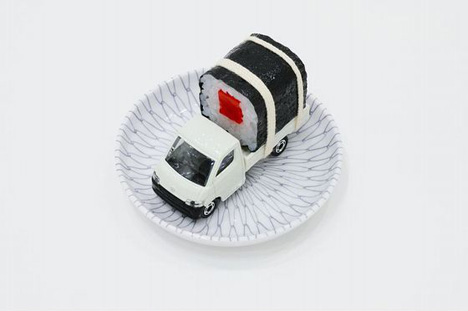The above piece is called tommy sushi and it is featured in a series of similar sculptures that merge TOMY toy cars, plastic food models used by restaurants, and the dishes accompanying those cuisines.
Teriha Faye Yaegashi's interpretation from online gallery AZITO is too good not to repeat verbatim:
"Strapped down to the toy cars, the plastic foods are readily docked onto the very dishes which would be used in their consumption. Yet, the cars cannot budge from the perimeter of the dish; the food cannot be consumed; and the viewer recognizes the paradox in having the exact collection of items needed for transporting food onto the table and into our mouths - and yet, not being able to perform either unction."
The best part? They're for sale!
Japan Society had a wild exhibition in Spring 2005 called Little Boy: The Arts of Japan’s Exploding Subculture, a major exhibition not only featured in our gallery but also in installations of artwork in New York City’s public spaces and mass transit system. Like Paramodel, the art dealt heavily in the omnipresent plastic toys that have infiltrated our lives. So of course, Godzilla and a pair of Gundams were there, along with fantastic installation pieces like Teruhisa Kitahara's collection of Japanese vintage toys from the 1960s - 1970s below.
The exhibition explored the phenomenally influential manifestations of otaku culture -- the subculture of “geeks” or “pop culture fanatics”-- a fantasy world where apocalyptic imagery, fetishistic commerce, and artistic vanguards meet. The otaku culture, which emerged in the early 1980s, is obsessed with darkly fantastic science fiction, video games, comic books (manga) and film animation (anime). Little Boy features work by leading creators of these popular forms as well as paintings, sculpture, and installations by contemporary Japanese Neo-Pop artists whose work draws from otaku culture.
The exhibition, public art projects, and accompanying book created a dynamic arena in which to discover what Japanese critics, artists and intellectuals consider the most exciting and challenging cultural developments in Japan today.
Curated by celebrated artist Takashi Murakami, Little Boy was the final installment of his Superflat trilogy, a series of exhibitions that have introduced a new wave of Japanese art and explored the interrelationships between vanguard art, manga and anime, and their forerunner, Ukiyo-e woodblock prints.


1 comment:
Formidavel Coleção!
Post a Comment